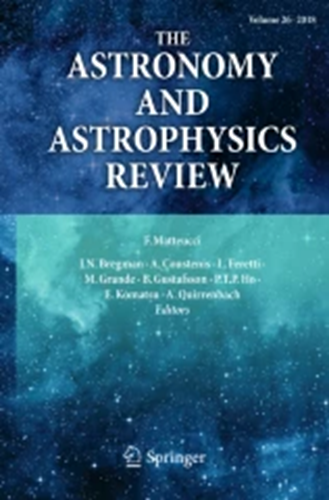测量低质量x射线双星中子星的质量和半径:大气成分和着陆半径的影响
IF 26.5
1区 物理与天体物理
Q1 ASTRONOMY & ASTROPHYSICS
引用次数: 2
摘要
上下文。x射线暴(XRBs)是在低质量x射线双星(LMXBs)中观测到的高能爆炸事件。一些i型XRBs表现出光球半径膨胀(PRE),这些PRE XRBs被用来同时估计LMXB中子星的质量和半径。目标质量和半径的估计依赖于几个模型参数,其中大多数仍然是不确定的。其中,我们重点研究了决定PRE阶段不透明度的光球化学成分和可能大于中子星半径的着陆半径的影响。我们研究了这两个模型参数如何系统地影响质量和半径估计,以及这两个参数是否存在统计趋势,包括它们之间的相关性。方法。我们使用蒙特卡罗(MC)采样和贝叶斯分析来发现光球组成和着陆半径的影响。我们将这两种方法应用于6个显示PRE XRBs的lmxb。在这两种方法中,我们都求解了Eddington通量方程和视角面积方程,这两个方程都包含了校正项。对于MC采样,我们开发了一种迭代方法,以便更有效地求解这两个方程。结果。我们证实,即使考虑校正项,在质量和半径的统计和分析估计中,光球组成和着陆半径的影响是相似的。此外,在所有六个源中,我们发现无论采用何种统计方法,统计上都倾向于H-poor光球和大的着陆半径。我们的贝叶斯分析还暗示,当光球层的氢含量较低时,着陆可能发生在离中子星表面较远的地方。这种关联可以用爱丁顿通量方程定性地理解。我们对光球组成与着陆半径之间的这种相关性提出了一种物理解释。我们的研究结果表明,在考虑光球组成和着陆半径的不确定性时,这6颗lmxb中子星的最可能半径小于12.5 km,这与引力波信号测量的潮汐变形能力所放置的中子星半径的界限相似。本文章由计算机程序翻译,如有差异,请以英文原文为准。
Measuring the masses and radii of neutron stars in low-mass X-ray binaries: Effects of the atmospheric composition and touchdown radius
Context. X-ray bursts (XRBs) are energetic explosive events which have been observed in low-mass X-ray binaries (LMXBs). Some Type-I XRBs show photospheric radius expansion (PRE) and these PRE XRBs are used to simultaneously estimate the mass and the radius of a neutron star in LMXB. Aims. The mass and radius estimation depends on a few model parameters most of which are still uncertain. Among them, we focus on the effects of the chemical composition of the photosphere which determines the opacity during the PRE phase and the touchdown radius which can be larger than the neutron star radius. We investigate how these two model parameters affect the mass and radius estimation in a systematic way and whether there is any statistical trend for these two parameters including a correlation between them. Methods. We use both a Monte Carlo (MC) sampling and a Bayesian analysis to find the effects of the photospheric composition and the touchdown radius. We apply these two methods to six LMXBs that show PRE XRBs. In both methods, we solve the Eddington flux equation and the apparent angular area equation both of which include the correction terms. For the MC sampling, we have developed an iterative method in order to solve these two equations more efficiently. Results. We confirm that the effects of the photospheric composition and the touchdown radius are similar in the statistical and analytical estimation of mass and radius even when the correction terms are considered. Furthermore, in all of the six sources, we find that a H-poor photosphere and a large touchdown radius are favored statistically regardless of the statistical method. Our Bayesian analysis also hints that touchdown can occur farther from the neutron star surface when the photosphere is more H-poor. This correlation could be qualitatively understood with the Eddington flux equation. We propose a physical explanation for this correlation between the photospheric composition and the touchdown radius. Our results show that when accounting for the uncertainties of the photospheric composition and the touchdown radius, most likely radii of the neutron stars in these six LMXBs are less than 12.5 km, which is similar to the bounds for the neutron star radius placed with the tidal deformability measured from the gravitational wave signal.
求助全文
通过发布文献求助,成功后即可免费获取论文全文。
去求助
来源期刊

The Astronomy and Astrophysics Review
地学天文-天文与天体物理
CiteScore
45.00
自引率
0.80%
发文量
7
期刊介绍:
The Astronomy and Astrophysics Review is a journal that covers all areas of astronomy and astrophysics. It includes subjects related to other fields such as laboratory or particle physics, cosmic ray physics, studies in the solar system, astrobiology, instrumentation, and computational and statistical methods with specific astronomical applications. The frequency of review articles depends on the level of activity in different areas. The journal focuses on publishing review articles that are scientifically rigorous and easily comprehensible. These articles serve as a valuable resource for scientists, students, researchers, and lecturers who want to explore new or unfamiliar fields. The journal is abstracted and indexed in various databases including the Astrophysics Data System (ADS), BFI List, CNKI, CNPIEC, Current Contents/Physical, Chemical and Earth Sciences, Dimensions, EBSCO Academic Search, EI Compendex, Japanese Science and Technology, and more.
 求助内容:
求助内容: 应助结果提醒方式:
应助结果提醒方式:


